All Rise: Resistance and Rebellion in South Africa is a four-part graphic history series. Based on little-known court records, each volume consists of six stories of resistance by marginalized South Africans against colonial and apartheid governments. This first installment, which spans the “Union period” of 1910-48, was researched and written by South African historian Richard Conyngham and each illustrated by a different South African artist. The stories in All Rise combine a variety of universal issues related to justice and human rights with a refreshing narrative medium. By foregrounding “anonymous” protagonists with lesser-known histories, the book breathes new life into a terrain of written history that until now has been dominated by icons.
Apartheid
Halley’s Comet
in the final years of South Africa’s Apartheid era, an unlikely trio-a sheltered white rugby player, a black farmworker’s son, and an Indian shopkeeper’s daughter-discover the consequences of knowing the truth and having the courage to speak it. Halley’s Comet is the coming-of-age story of Pete de Lange, a white 16-year-old schoolboy, set in small-town South Africa in 1986. Pete lives a relatively sheltered life, primarily concerned with girls and rugby- until one January night changes everything.
Thrust together with two complete strangers-Petrus, a black farmworker’s son and Sarita, an Indian shopkeeper’s daughter-the trio find themselves running for their lives from the vicious Rudie, whose actions will ripple far beyond that fateful night. This era-defying friendship-sparked by a shared secret- challenges everything Pete thought he knew and believed. And when anti-Apartheid revolutionaries set their sights on the town, it will change the course of the three young people’s lives forever.
Halley’s Comet is a story of friendship, love, change, taking chances, hope, a comet, and some pretty cool 80s music.
Hector; a boy, a protest, and the photograph that changed apartheid
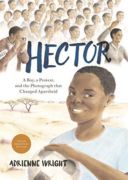
On June 16, 1976, Hector Pieterson, an ordinary boy, lost his life after getting caught up in what was supposed to be a peaceful protest. Black South African students were marching against a new law requiring that they be taught half of their subjects in Afrikaans, the language of the White government. The story’s events unfold from the perspectives of Hector, his sister, and the photographer who captured their photo in the chaos. This book can serve as a pertinent tool for adults discussing global history and race relations with children. Its graphic novel style and mixed media art portray the vibrancy and grit of Hector’s daily life and untimely death. Heartbreaking yet relevant, this powerful story gives voice to an ordinary boy and sheds light on events that helped lead to the end of apartheid.
Grandad Mandela
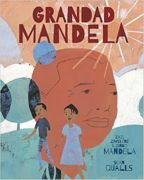
Nelson Mandela’s two great-grandchildren ask their grandmother, Mandela’s youngest daughter, 15 questions about their grandad – the global icon of peace and forgiveness who spent 27 years in prison. They learn that he was a freedom fighter who put down his weapons for the sake of peace, and who then became the President of South Africa and a Nobel Peace Prize-winner, and realise that they can continue his legacy in the world today. Seen through a child’s perspective, and authored jointly by Nelson Mandela’s great-grandchildren and daughter, this amazing story is told as never before to celebrate what would have been Nelson’s Mandela 100th birthday.
When Morning Comes
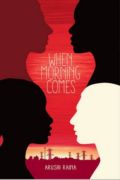
Zanele is skipping school and secretly plotting against the apartheid government. The police can’t know. Her mother and sister can’t know. Her best friend Thabo, schoolboy turned gang member, can tell she’s up to something. But he has troubles of his own–a deal gone wrong and some powerful enemies. Across the bridge, in the wealthy white suburbs, Jack plans to spend his last days in Johannesburg burning miles on his beat-up Mustang–until he meets a girl with an unforgettable face from the simmering black township–Soweto. Working in her father’s shop, Meena finds a packet of banned pamphlets. They lead to a mysterious black girl with a secret, a dangerous gangster with an expensive taste in clothes, and an engaging white boy who drives a battered red car. A series of chance meetings changes everything. A chain of events is set in motion–a failed plot, a murdered teacher, and a secret movement of students that has spread across the township. And the students will rise.
Mama Africa!
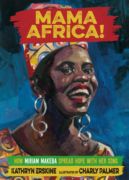
Miriam Makeba, a Grammy Award–winning South African singer, rose to fame in the hearts of her people at the pinnacle of apartheid―a brutal system of segregation similar to American Jim Crow laws. Mama Africa, as they called her, raised her voice to help combat these injustices at jazz clubs in Johannesburg; in exile, at a rally beside Dr. Martin Luther King, Jr.; and before the United Nations.
The World Beneath

South Africa, 1976. Joshua lives with his mother in the maid’s room, in the backyard of their wealthy white employers’ house in the city by the sea. He doesn’t quite understand the events going on around him.
Blood Runner: The Long Race to Freedom
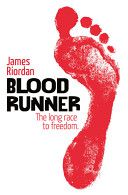
Samuel’s parents and young sister, innocent bystanders during an uprising, are killed by South African police. Samuel is sent to live with his uncle, a tribal chief in the Bantu homeland, while his brother vows to join the African National Congress armed struggle and avenge his family’s deaths. In the homeland, Samuel discovers he can run faster than anyone and before long begins to train under his English-educated uncle. Years later, after the end of Apartheid, Samuel is selected as the token black South African athlete to run in the Olympics. President Nelson Mandela is there when he wins his gold medal, and Samuel dedicates it to ‘a very special man… I was running for the President. I was running for my country. This powerful and moving story portrays what it was like for blacks growing up in South Africa aunder Apartheid and the different ways in which they struggled to gain their freedom. For some, like Samuel’s brother, it was an armed struggle, but for Samuel it was the opportunity to prove he could run better than any white man.
Waiting For The Rain (Laurel Leaf Books)
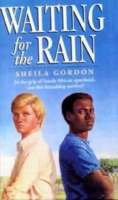
Tengo is the 10-year-old son of workers on Oom Koos’s large farm in the Transvaal. He longs to go to school like his friend Frikkie, who visits his uncle’s farm on holidays. But Tengo’s family is too poor to pay for the education that comes free to whites. He finally gets his wish at age 14. Tengo goes to live with his cousin in a squalid township outside Johannesburg and studies furiously. After three years, he is almost ready for college, but a year-long school boycott ruins his chances and he is drawn into the fight against apartheid. When he and Frikkie meet in a violent confrontation, Tengo realizes that he will carry on the struggle for freedom as a scholar, not a soldier. The writing here is powerful, evoking in minute detail daily life and the broad landscapes of the country.
Nelson Mandela: Long Walk to Freedom
Nelson Mandela’s autobiography offers a glimpse into the mind of a great leader, admired across the globe for his dedication to the struggles against apartheid in South Africa. Now the youngest readers can discover the remarkable story of Mandela’s long walk from ordinary village boy, to his dynamic leadership of the African National Congress, to his many long years in prison–and, at last, his freedom and astonishing rise to become the leader of his country.
